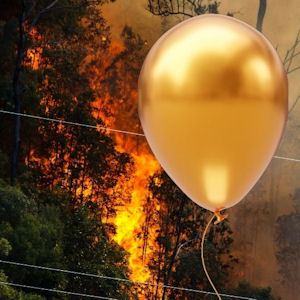Balloons and Bushfires
Categories: Naming Ceremonies | Wedding Ceremonies | Wedding Rituals | Wedding Planning |

Balloons are a festive addition to
many celebrations. Helium-filled balloons released
during ceremonies make for great photos, provide
opportunities for expression of joy, loss, and
release, and for great photos.
However, despite growing recognition of their impact on wildlife through ingestion or entanglement, particularly those that live in and around the sea, together with land-based wildlife, and active banning by a few jurisdictions in Australia of mass releases, a balloon release is a common request, particularly at naming and funeral ceremonies.
But did you know that released balloons are also a potential fire-hazard?
Helium and balloons
There are two types of balloons on the market that are commonly used in balloon releases and for decorations - latex (rubber) and Mylar (foil), each with their own specific hazard-creating properties, together with hazards that are common to both.
Mylar (Foil) Balloons as a
Bushfire Hazard
However, despite growing recognition of their impact on wildlife through ingestion or entanglement, particularly those that live in and around the sea, together with land-based wildlife, and active banning by a few jurisdictions in Australia of mass releases, a balloon release is a common request, particularly at naming and funeral ceremonies.
But did you know that released balloons are also a potential fire-hazard?
Helium and balloons
out
Balloons destined to be part of a balloon release are
generally filled with with helium. Helium allows the
balloon to rise and float, carried on wind and thermal
updrafts for long distances. While helium is an inert
gas that does not burn, its role in allowing balloons
to travel great distance, together with what the
balloons are made of and what may be attached to them,
constitutes a risk of not only spreading a fire, but
also of causing it. There are two types of balloons on the market that are commonly used in balloon releases and for decorations - latex (rubber) and Mylar (foil), each with their own specific hazard-creating properties, together with hazards that are common to both.
Mylar (Foil) Balloons as a
Bushfire Hazard
out
Mylar
(foil) is a lightweight metallised
nylon material that is more efficient at keeping
helium from escaping than latex. Mylar balloons
constitute a bushfire hazard because- they can stay afloat for several weeks
- they conduct static electricity.
Latex Balloons as a Bushfire
Hazard
out
Latex balloons are normally filled with either helium or
air. Helium doesn't support flames, air does. The issue,
as with Mylar balloons is the balloon itself, what's
attached to it, and how far it can travel.Natural latex is not highly flammable, however it can and does burn. To make a latex balloon fire resistant you would have to fill it with water, which means it won't float.
When latex balloons are filled with helium so that they float, they typically retain their buoyancy for only a day or so because they deflate fairly quickly as the helium escapes through small pores in the latex. Helium atoms are smaller than those pores. The larger the balloon, the longer the float time. However, if inside of a latex balloon is coated with a special gel to reduce helium leakage, the float time is increased two or three-fold.
Ironically, latex balloons filled with air usually hold their size and shape much longer, because air molecules are larger and slower moving than helium molecules, so air doesn't escape as quickly as helium would. While they may not rise to such heights, we've all had the experience of an air-filled balloon taking off when inadvertently released. On a windy day an air-filled balloon could travel significant distances.
Bushfire hazards common to
both types of balloons
out
The
capacity to travel great distances over periods of
time is a feature of balloons, particularly helium
filled balloons, so potentially a balloon released
in a low-fire risk area, or on a low-fire risk day,
could stay aloft long enough and travel far enough
to constitute a fire hazard where conditions are
different, or have changed.Flammable strings or ribbons attached to balloons also pose a risk, regardless of the type of balloon. Any contact with open flame or embers could allow the string to burn while the balloon is floating from one area to another, a potential to spread a fire.
Is it legal?
out
In Queensland, the release of balloons into the
environment is considered littering under the Waste
Reduction and Recycling Act 2011—whether released
deliberately or by accident.
In New South Wales releasing more than 20
balloons at a time is illegal under the Protection of
the Environment Operations Act 1997 No 156
(section 146E).
Play it safe
out
To play it safe- check whether there are restrictions on balloon releases in your area
- o not plan a release during summer, wherever you are
- be careful to ensure balloons used purely for decoration are weighted down and well anchored and therefore unlikely to escape
- be careful even with individual balloons
